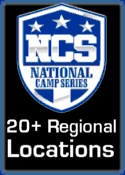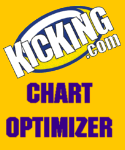|
GUEST EXPERT ARTICLE
Young kickers, like other young athletes, are awed by power. They look for anything that offers them the power "edge." Many young kickers believe that hitting the squat rack or leg extension machine is the only way to increase distance. The truth is that unless coupled with complete flexibility and speed programs, strength training can actually be counterproductive because it works the wrong muscle type (Type I, or "slow twitch") Power in kicking is a function of foot speed more than of bulk strength. Physical training should include more speed drills (plyometrics, short sprints, inclines, and timed sets with weights) that work the fast-twitch (Type II-B) muscles.
For the fastest results, young kickers need to look no further than their technique. Through consultation and research with camp directors, pro players and pro kicking consultants, I've pinpointed five mechanical concepts that will yield marked improvement in distance, trajectory and hang time on both field goals and kickoffs. Each is also aimed at correcting common mistakes made by young kickers, and will increase accuracy as well as distance.
Concept #1 - Left (Plant) Foot Drive
The plant foot (left foot for a right-footed kicker) should be the primary drive foot. This principle should be applied at two points in the kicking sequence. One is on the take-off. The front (or plant) knee should collapse, and the kicker should drive hard off that foot. The kicking knee should then drive up and forward, increasing the length of the first full step (what I call the "crossover" step because crossing over slightly helps maintain a straight path to the ball). At the same time, the body axis (or angle of the upper body's forward lean) at takeoff should be constant; merely falling forward is not enough and is a sure way to reduce the length of this step and throw off the proper lean at impact. When the first step is longer, the kicker gets a shorter, more controlled drive step.
When you look at your kicker's close-up workout tapes, watch for two things. First, make sure his first full step is as long as his drive step. Look for the left knee collapse and right knee drive. Second, make sure that his left foot hugs the ground on the way to the plant position. If he is airborne on the drive step and coming down steep, the drive step is too long. Learn more about Paul Perrone >>> |

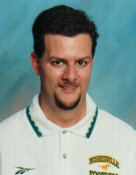 Five Keys to Power (Part 1)
Five Keys to Power (Part 1)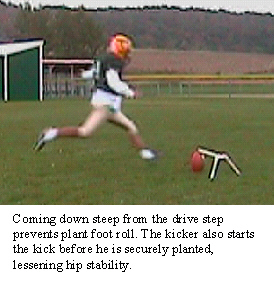 One common error young kickers make is to "lunge" at the ball on their drive, or final step (Photo 1). First, they start the kick before they are firmly planted, disallowing hip stability and throwing off the timing of their swing. Secondly, energy exerted by the kicking leg on the lunging drive step takes from the force that could be applied to the ball. Lastly, the force of their plant foot landing from the extra distance disallows them the chance to pull the foot out of the ground and down the field on the follow through.
One common error young kickers make is to "lunge" at the ball on their drive, or final step (Photo 1). First, they start the kick before they are firmly planted, disallowing hip stability and throwing off the timing of their swing. Secondly, energy exerted by the kicking leg on the lunging drive step takes from the force that could be applied to the ball. Lastly, the force of their plant foot landing from the extra distance disallows them the chance to pull the foot out of the ground and down the field on the follow through. 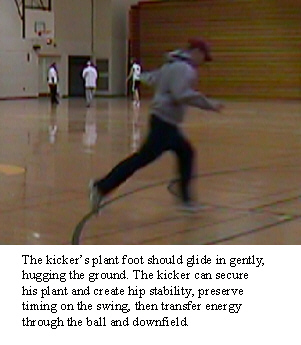 The second point for left foot drive is on the drive step itself; it should be just that - a step. The landing on the kicking foot that starts this step should be a "touch" - since the left foot has generated more drive, there is less of a need for drive off the kicking foot. The kicker should then not become airborne on the drive step, but rather "glide" in gently (Photo 2). The drive step should be no more than about six feet, and should be taken off the ball of the kicking foot, not the instep, to promote a straight approach path. All of this allows the kicker to create hip stability so that he drives his knee and "snaps", creating more consistent ball striking.
The second point for left foot drive is on the drive step itself; it should be just that - a step. The landing on the kicking foot that starts this step should be a "touch" - since the left foot has generated more drive, there is less of a need for drive off the kicking foot. The kicker should then not become airborne on the drive step, but rather "glide" in gently (Photo 2). The drive step should be no more than about six feet, and should be taken off the ball of the kicking foot, not the instep, to promote a straight approach path. All of this allows the kicker to create hip stability so that he drives his knee and "snaps", creating more consistent ball striking.
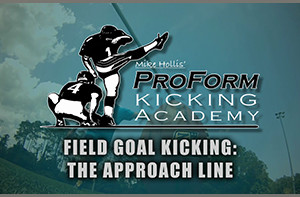

 Doug and Tommy's Frequently Asked Questions
Doug and Tommy's Frequently Asked Questions
